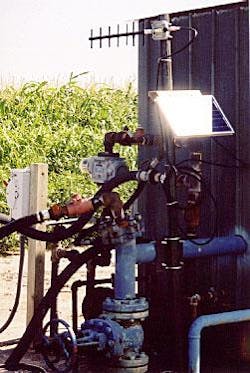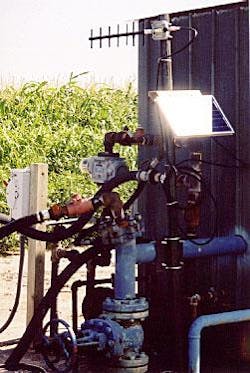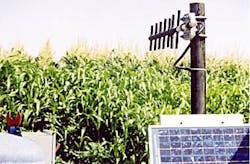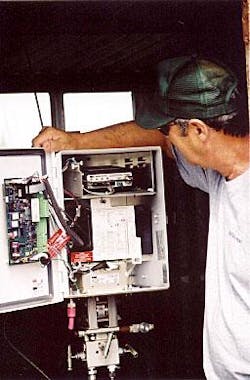Wireless hybrid radio technology plays a major role in automation of Pioneer Natural Resources Co. (PNR) operations in Hugoton field, Kansas.
Hugoton remains one of the most productive gas fields in the continental US and is a key asset for PNR. The company has a working interest in about 1,200 wells in Hugoton and owns nearly all gathering and processing facilities that service the field.
null
In May 1998, PNR determined manual field operations were no longer efficient or effective and began a data automation project at Hugoton in collaboration with Wireless Data Communications LLC, Liberal, Kan. The goal was to create an efficient, reliable, cost-effective network for data monitoring, acquisition, and control of remote compressor stations and natural gas wells.
A key part of the project involved designing and installing a multiple address radio system (MAS) as the communications link to remote sites. Wireless Data Communications and PNR's local field support personnel along with personnel from the remote-terminal unit (RTU) vendor and systems integrator collaborated together to complete the job.
Microwave Data Systems (MDS), Rochester, NY, provided the radio equipment and additional support.
License-free communications
In the first step in the project, PNR applied for a Federal Communications Commission (FCC) license for wireless operation at Ulysses, Kan. The company later decided to install a license-free system that involves less waiting time because it needed to get the system on the air quickly.
The multiple address system for Hugoton had two vital status-monitoring functions: collecting electronic flow measurements and monitoring field compressors reliably.
The initial system employed an MAS configuration of license-free MDS 9810 spread-spectrum radios.
A 9810 serves as the master station for remote stations at compressor sites within a 25-mile radius. The MDS 9810 is an advanced spread-spectrum transceiver that operates in the 902-928 Mhz band. It was designed specifically for telemetry and supervisory control and data acquisition (SCADA) applications in harsh environmental conditions such as those in Ulysses.
The radio uses direct asynchronous communications and deterministic data response times to maximize end-to-end system performance.
This radio system allowed PNR to obtain speedy implementation.
Obstacles
In many parts of southwest Kansas, including the region surrounding PNR's Ulysses facility, farmers use center pivot mechanical irrigation systems to water crops (Fig. 2). Center pivot systems typically are a quarter-mile long and irrigate an area of about 130 acres.
Because corn crops grow tall, the system incorporates towers that suspend irrigation pipes above the ground, up to 9 ft high. This complicates wireless radio because only antennas mounted lower than 9 ft can avoid destruction.
Also during the last few weeks before harvest, corn crops form tassels that cause the corn to be higher than 9 ft, thereby also obstructing the antennas, disrupting signal penetration, and increasing signal loss through absorption (Fig. 3).
Spread-spectrum uses 900-Mhz signals that travel primarily by line-of-sight. The corn crops, therefore, prevent a clear sight path and reduce or cut off entirely the spread-spectrum communications. This caused propagation problems in PNR's initial MAS (license-free spread spectrum) network.
Although the spread-spectrum system was still within the communication limits of PNR's compression monitoring, the reduced height of the remote station antennas and the FCC-imposed 1-w limit (on all license-free systems) compounded the problems with PNR's license free, spread-spectrum radios.
Licensed radios
PNR could have installed additional spread-spectrum units to combat the coverage problems, but this would have involved extensive reworking of the network.
Instead, PNR chose to add licensed MAS systems because of the increased power of licensed radios (which are not limited to 1 w) to monitor and control the collection of electronic flow measurements at well sites.
MDS provided the MDS 9710, a 5 w, fixed-frequency data transceiver that operates in the 900-Mhz spectrum.
With the combination hybrid system of licensed and license-free radios, PNR achieved its automation objectives and ideal communications rate percentages.
The MDS 9710 overcame the interference and difficult signal paths problems. Its 5-w power output offers predictable performance and considerably longer range than low power, spread-spectrum radios.
Even with minor obstructions, signals are much more likely to get through with a licensed, 5-w transceiver.
null
null
Field installation
Wireless Data Communications and PNR's field office personnel installed two licensed MAS systems using MDS 9710s in both simplex and half-duplex modes. The Ulysses production site now has one MDS 9810 (Fig. 4) and two MDS 9710 master stations transmitting and receiving data from about 840 remotes over two different frequencies (Fig. 5).
The 9810s retrieve run-status data from about 130 gas compressors, while the 9710s assist in monitoring and controlling flow rates for about 840 natural gas wells.
The 9810s poll compressors every 20 min, while the 9710 radios poll all 840 remotes in a 21/2-hr span, 5 times/ day.
The system operates daily, and PNR reports an average 97% communications rate over all three systems.
The licensed and license-free technologies combine to harness the benefits and minimize the limitations of each system.
Spread spectrum, licensed radios
In 1985, the FCC first allowed spread spectrum for use in commercial sectors of radio communications. Since then, unlicensed spread-spectrum technology has become a popular wireless solution because it eliminates the hassle, wait time, and cost of obtaining an FCC license.
null
Typical unlicensed systems in the US operate in the industrial, scientific, medical (ISM) bands, with the most common frequency range between 902-928 Mhz.
Instead of subdividing the band, the FCC mandates that each device operating in this range not exceed 1-w output power and accept any interference generated in the band. As a result, system design emphasizes reliable reception at low transmit power and restricted range.
To compensate for these limitations, manufacturers have incorporated such features as higher data throughput rates, store-and-forward, signal repeating, collision detection, and forward error correction.
When there are too many users in the same area, however, license-free radios have to "fight it out" to penetrate their signal through the noise. In the future, the high population of spread-spectrum systems could saturate some areas, and other solutions will be needed.
The FCC-mandated limit of 1 w of output power results in limited range and higher reliance on a clear line-of-sight signal path. In some locations, such as Ulysses, line-of-sight becomes a problem when the corn grows tall.
Licensed systems protect radios from interference. Before implementation, each licensed system is analyzed to evaluate its potential effect on other systems and the effect of the other systems on it. To minimize the chance of interference to and from other systems, licensed systems are coordinated to a frequency band, frequency pair, antenna size, and polarization.
The largest difference between the two systems is that there is no formal process for coordinating license-free users. It, therefore, is up to system owners, planners, and engineers to resolve interference problems.
In contrast, the licensing and regulatory process involved with licensed radio eliminates many potential sources of interference between radio users. The higher power allowance also provides greater distances and better reliability over less-than-ideal signal paths. Although licensed products are still line-of-sight devices, they can tolerate minor obstructions that could completely block communication in lower powered spread-spectrum systems.
In recent years, and with good reason, more companies have embraced spread-spectrum technology, but the noise floor will rise as the trend continues. The unlicensed spectrum could become overtaxed, especially in densely populated zones.
null
Licensed radio is less likely to have problems with interference, and manufacturers are keeping stride with the features found on the best spread-spectrum radios. The advantages of higher wattage, reliability, and improved signal propagation will allow these systems to remain a viable option well into the future.
It is safe to say that hybrid solutions will become more common as designers seek to balance performance, capabilities, and cost considerations in a variety of applications.
Acknowledgment
In preparing this article, the authors appreciate the help of Cheryl Matochik, marketing writer for Microwave Data Systems.
The authors
Don Ukens ([email protected]) is co-owner and head of automation sales for Wireless Data Communications LLC, Liberal, Kan. He has been involved in automation communications for nearly 20 years. Prior to forming Wireless Data Communications, he served 7 years in the US Navy working on secure communications equipment. Ukens is a Board Member of the Oklahoma Department of Environmental Quality.
Robert E. Carroll (carrollr@ pioneernrc.com) is lead instrumentation and electronics technician for Pioneer Natural Resources Co. in Ulysses, Kan. He has 35 years of experience in the electronics industry.








